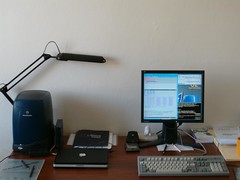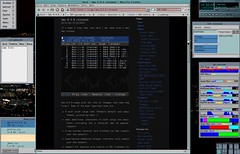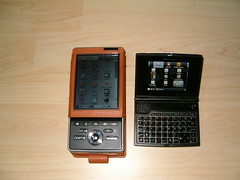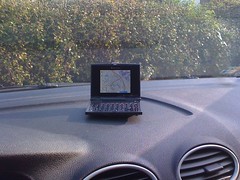Before some time (a year or so) Logout asked me to write an article about my daily life with my SGI O2 workstation. Honestly, some things have been changed from that time. I even started to use a products of the Microsoft. But only in the work, of course (I still refuse to take something strange to my home). And, I don’t use my O2 to write this text. I’m doing that while siting on the sofa in our living room andwhile using my Psion MC600 laptop (yes, that weird thing that can run 60 hours on a set of 8 AA batteries). Anyway, I can connect my MC600 to my O2 workstation and transfer the text via the Kermit.
Of course I can not add images to the article without the O2.
So how powerfull is my main workstation? It’s the SGI O2 with the MIPS R10000 processor (at 250 MHz) and with a maximum possible 1 GB of RAM. Your phone has higher CPU clock and most probably also somewhat larger RAM, doesn’t it have?
A full report about my hardware:
CPU: MIPS R10000 Processor Chip Revision: 3.4 FPU: MIPS R10010 Floating Point Chip Revision: 0.0 1 250 MHZ IP32 Processor Main memory size: 1024 Mbytes Secondary unified instruction/data cache size: 1 Mbyte on Processor 0 Instruction cache size: 32 Kbytes Data cache size: 32 Kbytes FLASH PROM version 4.18 Integral SCSI controller 0: Version ADAPTEC 7880 Disk drive: unit 2 on SCSI controller 0 CDROM: unit 4 on SCSI controller 0 Integral SCSI controller 1: Version ADAPTEC 7880 On-board serial ports: tty1 On-board serial ports: tty2 On-board EPP/ECP parallel port CRM graphics installed Integral Ethernet: ec0, version 1 Iris Audio Processor: version A3 revision 0 Video: MVP unit 0 version 1.4 AV: AV1 Card version 1, Camera not connected. Vice: TRE 1600SW Flat Panel adapter board and display.
So, what is my typical work on the computer? There are actually only a
few task that I done often:
- Writing of texts (lectures, presentations for my work, scientific
articles and so on) with use of LaTeX (good old CSLaTeX with standard packages for the most of this work and LaTeX Beamer for presentations which require a bit better look). I use the Vim (GVim) and the Ispell here (and few other small tools). - Programming in the GNU Octave. I do this mostly as a preparation for my teaching and sometimes also when I need to test various stuff.
- Programming in the C language (CLI programmes usually, but I’m also doing some Gtk+ and OpenGL stuff). I still use Gtk+ 2.x and OpenGL 1.1. It’s because most of my code uses them and I don’t have enough time just to rewrite 100000+ lines of working code in order to be more modern. The C that I’m trying to use is the ANSI89 standard but I also actively use and (well, much less actively) a code which use the old K and C standard (that thing was initially developed to run on a really old machine where modern compilers cannot run but I used to use it more regularily). It is a fun to have a code that actually can run on a PDP-11, isn’t it?
- Some actual computing: a finite element analysis of building and underground structures. I can do here only a relatively small computations. But it’s usualy fine for me. I use my own software for these tasks (there are some open source packages for these tasks, like the Z88 or the FElt, but I have a limited experience with them).
- Creating of images with the XFig or (much less often) with the QCAD: warious small illustrations fopresentations adn articles, simple schemes and so. I also make graphs with the Gnuplot.
- Viewing of images (I do no editing of photos) with programs like the XV and the GQview.
- Sometimes I listen the music. Radios in MP3 with the XMMS and CDs (yes, that silver discs – I have a good selection at home) with the build-in CD Player.
- E-mail. Well, I use the Thunderbird. It isn’t slow and it just works.
- Web browsing. That’s probably the biggest problem. I use the Gopher when possible (but today there is not too much possibilities: the Gopherpedia, the gopher pages of Logout and a few more). If an access of the WWW is necessary, I use the Links browser (a graphical one). If it is not enough the I have to use the Firefox 3.x (nothing better is available on the IRIX). Do I care about the security? Yes. So I access web servers with sensitive data only from my laptop with an up-to-date Linux (it’s a IBM T23 with the Debian). Some web pages are not accessible with the Firefox 3.x at all. So I have to use the laptop also for these pages.
- Office stuff? Yes, there is the OpenOffice available (the version 1.0.3), there is the Ted Text Editor (it can edit RTF files) and more but I actually wrote less than 10 pages of word documents and made few simple spreadsheet tables at home during the whole time that I own the O2 (it’sabout 10 years). If I have to make a table then I prefer to use the “sc” spreadsheet. It is usually mere than enoug for my needs.
Do I forgot something? Most probably, yes. Games, for example? Printing and scanning? Synchronisation with my PDAs? Well, these hings can be topics of further articles.





